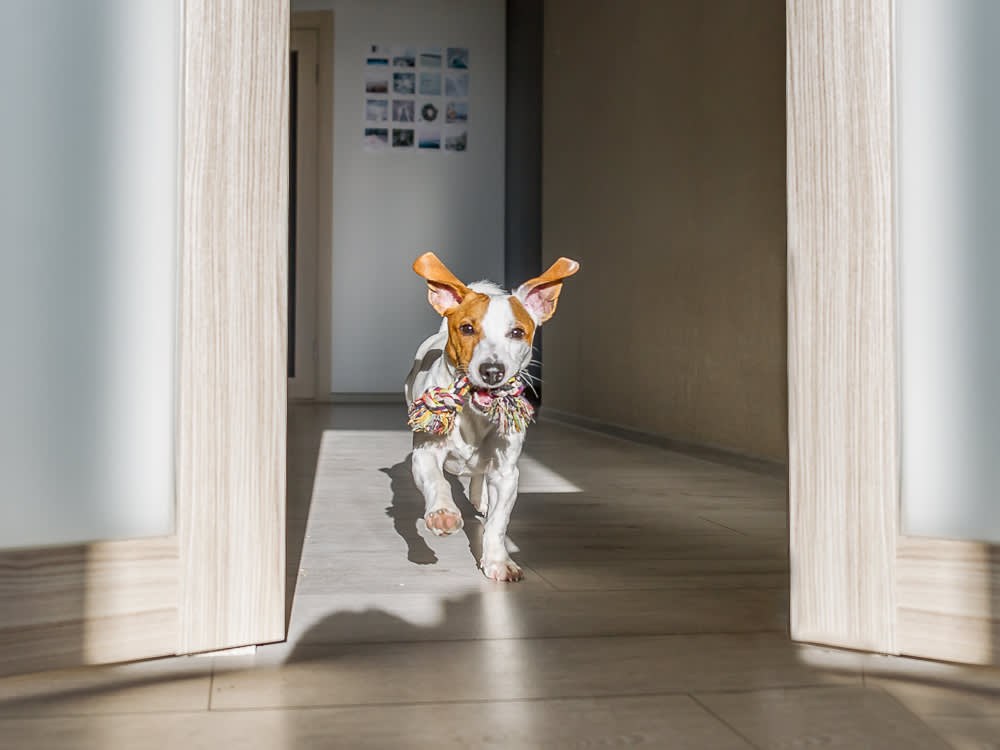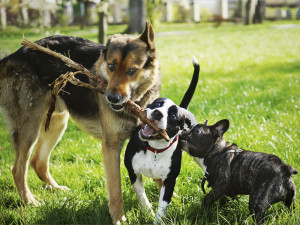6 Things to Know About Dog Zoomies
Not counting how fun they are to watch

Share Article
Zoomies have been a part of my life far longer than Zoom meetings. I’ve enjoyed watching dogs do the zoomies in the garden or at the park, racing around an open space, as well as inside – leaping over the coffee table and running along the back of the couch. Zoomies are one of the most charming and entertaining of canine behaviours. But why do dogs get zoomies? Below, everything you need to know.
1. There’s a technical term for the zoomies
Scientifically speaking, zoomies are frenetic random activity periods, or ‘FRAPs’. It has been theorised that FRAPsopens in new tab allow animals to relieve stress, let out stored-up energy, and handle excitement and play – but the function of frapping is still unknown.
2. Zoomies involve furious bursts of speed
Dogs with the zoomies will run in wide circles in a series of laps and may exhibit repetitive spins. They often break into a sprint suddenly; their bottom tucked as they go; a wild, excited look in their eyes; and lots of sharp turns, spins or sudden changes in direction.
3. There are a lot of precursors to the zoomies
Zoomies can happen when dogs get revved up or aroused, when they go out after being inside for a while, when they see another dog, when their favourite person comes home, or in the snow. It’s also common following a few other circumstances: a bath, pooing, grooming, and being released from a crate or any other form of restraint.
4. Dog zoomies are normal
There is nothing wrong with this normal dog behaviour – as long as your dog doesn’t run around in a place that is unsafe, such as near a road or through a part of the garden with dangerous objects. Though zoomies are not problematic, sometimes dogs that chase their tails are mistaken for having the zoomies when they’re actually showing symptoms of obsessive-compulsiveness.
5. Zoomies don’t last long
Most of the time, a case of the zoomies lasts less than a few minutes. Although they have been known to extend over 10 minutes, that is not typical.
6. It’s difficult to stop dog zoomies, but not impossible
It’s hard to stop a dog mid-zoom, so it is usually easiest to wait out these short-lived actions. You can redirect their motion by running away from them so they chase you to a safer spot if need be. Or, you can throw a toy in the direction you want a dog to go. The better your dog’s recall, the sooner they will come to you as their zoomies wind down. Whatever you do, don’t chase a dog with the zoomies as that will only add excitement to the moment and make it harder for your dog to calm down.

Karen B. London, PhD, CAAB, CPDT-KA
Karen B. London, Ph.D., is a Certified Applied Animal Behaviorist and Certified Professional Dog Trainer who specializes in working with dogs with serious behavioral issues, including aggression, and has also trained other animals including cats, birds, snakes, and insects.
Related articles
![Black puppy chews on a frozen Kong treat]()
Why Your Dog Needs a Frozen Kong
Two words: endless entertainment
![A dog laying on a couch peacefully.]()
Is an Underactive Thyroid to Blame For Low Energy?
If hypothyroidism is to blame, it’s best not to let sleeping dogs lie
![Three dogs biting a stick.]()
Some Like It Rough: Playing vs Fighting
Two animal behaviour experts agree that it’s usually play fighting. Here’s how you can tell
![Owner serving dog food]()
Your Dog’s Food Aggression Isn’t Cute – Here’s How You Can Work On It
No longer associate feeding time with growling time
![A young woman standing next to her bike with the dog in the basket]()
How to Take Your Dog on a Bike Ride
So they can feel the wind in their fur






